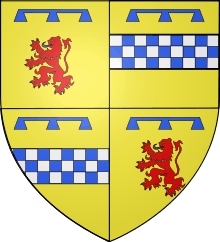Andrew Stewart, 1st Lord Avandale


Andrew Stewart (c. 1420 – 1488) was Lord Chancellor of Scotland from 1460 to 1482 and one of the leading servants of King James III of Scotland.
Early life
Andrew Stewart was born c. 1420[1] and "appears to have been the eldest son of Walter Stewart (c.1392–1425), second son of Murdoch Stewart, Duke of Albany (c.1362–1425), and Isabella, Countess of Lennox (d. 1458/9)... Andrew, together with brothers Arthur and Walter, obtained letters of legitimation from James III in 1472, repeated in 1479."[1] His grandfather Murdoch Stewart, Duke of Albany was executed for treason in 1425 by King James I of Scotland.[2][3][4]
Andrew Stewart was raised at the court of his paternal grandmother Isabella, Countess of Lennox.[5] It may be that Isabella, having seen her own children and husband executed by James I of Scotland, took pity on her dead son's children and brought them to her own court.
Andrew attended a university in England, in which country he was knighted before 12 July 1437 with his brother Murdoch. As well as Murdoch and Marion, two other siblings, Arthur and Walter, are known.
Return to Scotland
Returning to Scotland by 1440, he attended the Parliament of Scotland at Stirling that year. He probably served as a member of the Royal Household of King James II and was granted lands, including Avandale and Strathavon, which were forfeited by William Douglas, 8th Earl of Douglas. By 11 June 1457 he had been granted the title Lord Avandale. In 1460 he was appointed Chancellor by King James II of Scotland who died later that year.
Lord Chancellor of Scotland

Avandale retained the officer of Chancellor, and may have briefly served as regent, during the minority of King James III of Scotland. He then served as governor of Stirling Castle and as an ambassador and diplomat, taking a leading role in the negotiations which led to the marriage of James and Margaret of Denmark in 1469. In 1471 he was granted the rents of the Earldom of Lennox for life.
Replacement as Lord Chancellor
During the crisis of 1482, when James III declared war on England for protecting his brother Alexander Stewart, Duke of Albany, who had rebelled and was given sanctuary by the Duke of Gloucester, who later became King Richard III. When Albany and his English allies invaded Scotland, Lord Avandale was one of the faction who refused to fight and then proceeded to arrest the King. Albany then proclaimed himself King Alexander IV of Scotland and immediately began to alienate the nobles by his harsh policies, especially the powerful George Gordon, 2nd Earl of Huntly.
On Alexander's orders, Lord Avandale was then stripped of the Chancellorship because he had captured Albany's castle of Dumbarton for the King in 1479. He was replaced as Lord Chancellor by John Laing, the Bishop of Glasgow. Because of Alexander's treatment of the nobles, James III had been able to gain back most of their support and in 1483 with help from the Earl of Huntly, James was able to call a Parliament that condemned Albany as a traitor and forced him into exile for a second and final time. Avandale had been present at the Parliament and the following year he was one of the ambassadors sent to Louis XI of France. After this he appears to have largely withdrawn from public business. He died in 1488[6] and was succeeded by his brother Walter's son Alexander.[1] Alexander died c. 1500 and the title Lord Avandale passed to his son, Andrew Stewart, 2nd Lord Avandale.
Ancestry
| Ancestors of Andrew Stewart, 1st Lord Avandale | ||||||||||||||||||||||||||||||||||||||||||||||||||||||||||||||||||||||||||||||||||||||||||||||||||||||||||||||||||||||||||||||||||||||||||||||||||||||||||||||||||||||||||||||||||||||||||||||||||||||||||||||||||||||||||||||||||||||||||||||||||||||||||||||||||||||||||||||||||||||||||||||||||||||||||||||||
|---|---|---|---|---|---|---|---|---|---|---|---|---|---|---|---|---|---|---|---|---|---|---|---|---|---|---|---|---|---|---|---|---|---|---|---|---|---|---|---|---|---|---|---|---|---|---|---|---|---|---|---|---|---|---|---|---|---|---|---|---|---|---|---|---|---|---|---|---|---|---|---|---|---|---|---|---|---|---|---|---|---|---|---|---|---|---|---|---|---|---|---|---|---|---|---|---|---|---|---|---|---|---|---|---|---|---|---|---|---|---|---|---|---|---|---|---|---|---|---|---|---|---|---|---|---|---|---|---|---|---|---|---|---|---|---|---|---|---|---|---|---|---|---|---|---|---|---|---|---|---|---|---|---|---|---|---|---|---|---|---|---|---|---|---|---|---|---|---|---|---|---|---|---|---|---|---|---|---|---|---|---|---|---|---|---|---|---|---|---|---|---|---|---|---|---|---|---|---|---|---|---|---|---|---|---|---|---|---|---|---|---|---|---|---|---|---|---|---|---|---|---|---|---|---|---|---|---|---|---|---|---|---|---|---|---|---|---|---|---|---|---|---|---|---|---|---|---|---|---|---|---|---|---|---|---|---|---|---|---|---|---|---|---|---|---|---|---|---|---|---|---|---|---|---|---|---|---|---|---|---|---|---|---|---|---|---|---|---|---|---|---|---|---|---|---|---|---|---|---|---|---|---|---|---|
| ||||||||||||||||||||||||||||||||||||||||||||||||||||||||||||||||||||||||||||||||||||||||||||||||||||||||||||||||||||||||||||||||||||||||||||||||||||||||||||||||||||||||||||||||||||||||||||||||||||||||||||||||||||||||||||||||||||||||||||||||||||||||||||||||||||||||||||||||||||||||||||||||||||||||||||||||
References
 "Stewart, Andrew (d.1488)". Dictionary of National Biography. London: Smith, Elder & Co. 1885–1900. Retrieved November 2010
"Stewart, Andrew (d.1488)". Dictionary of National Biography. London: Smith, Elder & Co. 1885–1900. Retrieved November 2010- Boardman, Steve, The Campbells 1250–1513.
- Harvey, Johnson G., p. 93, Scottish Heraldry Made Easy Retrieved November 2010
- Nelker, Gladys P, The Clan Steuart, Genealogical Publishing (1970)
Notes
- 1 2 3 Alan R. Borthwick, ‘Stewart, Andrew, Lord Avondale (c.1420–1488)’, Oxford Dictionary of National Biography, Oxford University Press, 2004 accessed 27 June 2016
- ↑ James Beag Stewart at Stewarts of Balquhidder webpage Retrieved November 2010
- ↑ Nelker, p.19
- ↑ Dictionary of National Biography, 1885-1900, Volume 54. This source suggests he was the son of Walter Stewart, who died in 1425, executed along with his father the Duke of Albany. Retrieved November 2010
- ↑ Napier, Mark (1835). History of the Partition of the Lennox. W. Blackwood and sons. p. 13. Retrieved November 2010. Check date values in:
|access-date=(help) - ↑ Harvey, Johnson G., p.93, Scottish Heraldry Made Easy Retrieved November 2010
| Political offices | ||
|---|---|---|
| Preceded by George de Schoriswood, Bishop of Brechin |
Lord Chancellor of Scotland 1460–1482 |
Succeeded by John Laing, Bishop of Glasgow |
| Peerage of Scotland | ||
| Preceded by New Creation |
Lord Avondale 1459–1488 |
Succeeded by extinct |